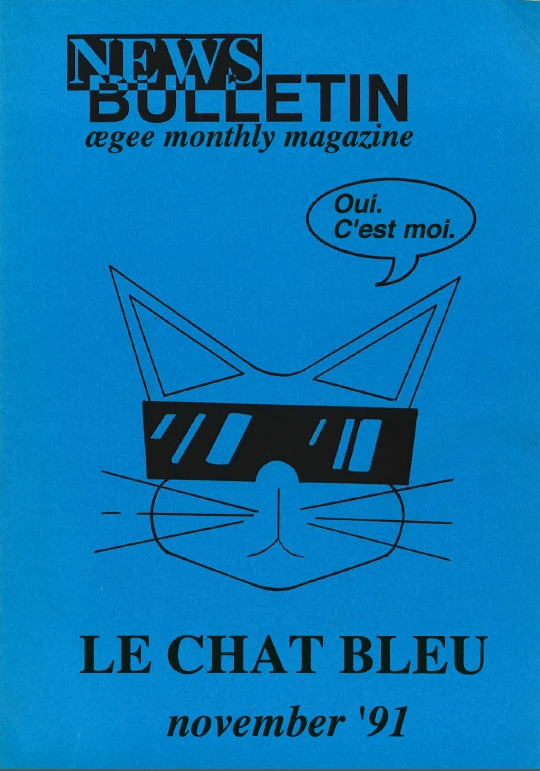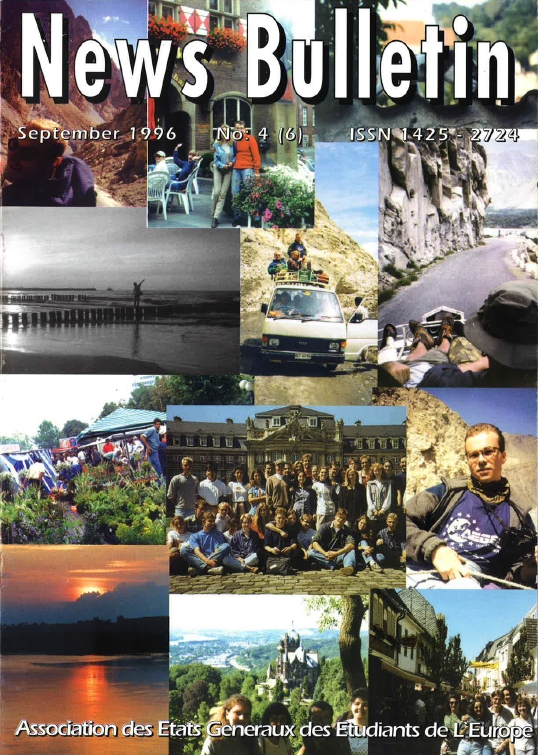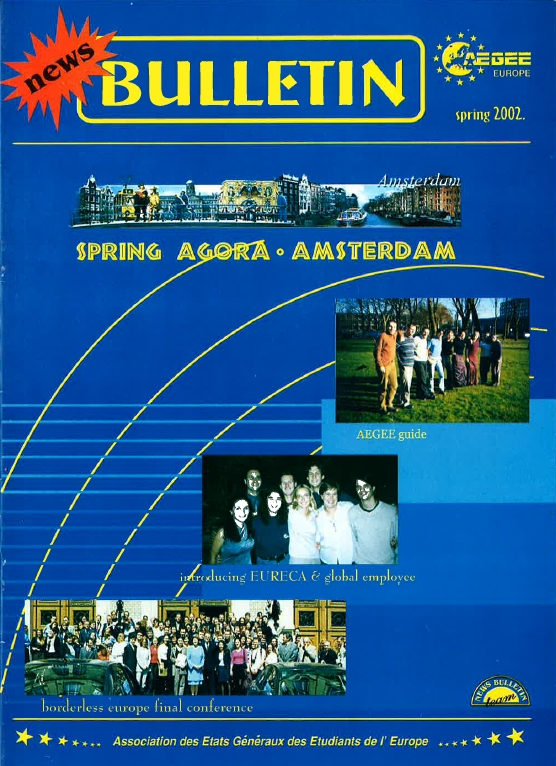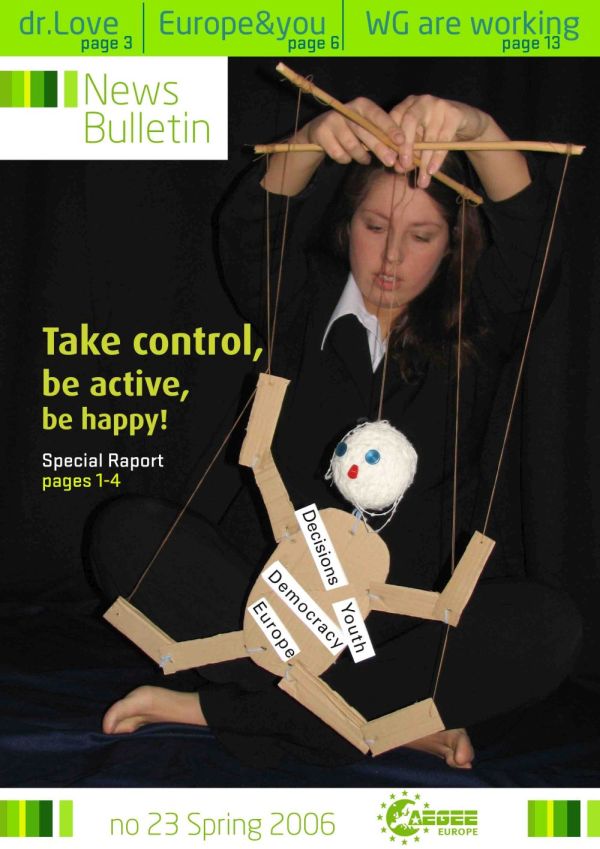It was once AEGEE’s main information source: the News Bulletin. When it was created in 1987, there was no Internet in AEGEE, no cheap phone numbers, no cheap airlines and the number of events was less than 50 per year – which is less than a quarter of what it is today. In other words: getting information about what was going on, was really hard. And this in the era of change in Europe, when the Berlin Wall fell and the AEGEE members were hungry to become active in the association. In case you want to find out about how AEGEE was in the beginning and developed over time, this is the most original and unbiased source. The Golden Times is scanning and publishing as many issues as I can get hold of.
It was no surprise that the News Bulletin became an immediate success. However, it started under a different name: In January 1987 AEGEE-Kiel and CD member Johannes Heister created the Information Bulletin. After ten editions he handed over this task to AEGEE-Toulouse. The French antenna published their first NewsBulletin under this new name in December 1987. However, they were not so happy about this task and handed it over to AEGEE-Amsterdam in June 1988.
In December 1989 it was taken over by Maria Alvarez and her friends from AEGEE-Oviedo, where it really started to flourish. The University of Oviedo paid the biggest part of it. So the editors team published one edition every month! In these early years, the News Bulletin was a place for event PR, board announcements and discussions. A must-read for everyone.
This is what Maria Alvarez told the editors of AEGEE-Europe’s 10th Anniversary Book about their work: “During those years the News Bulletin witnessed the fastest period of changes in AEGEE. The times when AEGEE opened itself to the East, to the North and in some way, also to the South; when the idea of European Community was replaced by the ‘Idea of Europe’. The times of expansion in other fields of interest, of the Cooperation with other Associations, of the active Working Groups, of the dissemination of the Comité Directeur and the growing of the Address Book and the Calendar of Events. It was quite a lot what we, members at that time, inherited; but it was treated well and it was more what was left to those coming after.”
The NewsBulletin stayed in the hands of AEGEE-Oviedo until 1993, then it was taken over by AEGEE-Madrid. After that, from 1995 until 1997, Marcin Polak and his team in AEGEE-Warszawa took care of it. When they stopped, the Golden Age of the News Bulletin was over – and more and more information was distributed via the growing number of mailing lists. Nevertheless, it continued to be published until 2008, although there were only one number in the end per year. “The idea was that many members are reading the Key to Europe, specific AEGEE-internal articles were supposed to be published online”, recalls Verena Schmidt from AEGEE-Tübingen, last chief-editor of the News Bulletin. “You can regard The AEGEEan as a replacement for the News Bulletin.”
In the 20th Anniversary Edition of the Key to Europe (Key20), we published an interview with former News Bulletin chief editor Maria Alvarez. This is what she said about the News Bulletin – in the full version, which is twice as long as what was published in the Key20.

Key20: You became famous for publishing the News Bulletin for AEGEE-Europe. Every month, without e-mail.
Maria Alvarez: We, in Oviedo, took the torch of Jeroen [Hoogerwerf] in Amsterdam and began the publication of the monthly News Bulletin. First only 300 copies, shortly increasing to 1500 copies printed and distributed to 200 to 250 addresses all over Europe. In AEGEE-Oviedo we published 27 editions of the Newsbulletin. Times were so different then: no mobiles, no digital cameras, no Internet, no e-mail, weak software and almost no laser printer. It sounds like if we are talking about prehistory, but it was just one decade ago. We had a post office box where we received all the letters and photos, and tried our best to rewrite texts received by post or fax. The result, our News Bulletin, would look now like a school newsletter, but fifteen years back it really looked great, at least for us.
How do you see the importance of this communication tool in pre-Internet times for the association?
Maria Alvarez: Before the Internet, the antennae could only receive information by the different newsletters, which was really expensive and slow. In 1990 we moved to laser printers and we opened our first EARN account. EARN, the European Academic and Research Network, was the first computer network for communications in Europe widely used for scientific, educational, academic and research purposes with 500 institutions then, including the founder CERN. Our first EARN-Bitnet account was an ancestor of an e-mail, but we did not get much messages there, for there were few antennae who could get an account by themselves. Nevertheless, we can say that AEGEE was a pioneer in using e-mail.
How was it possible to make the News Bulletin so often? How did you get the ideas and money?
Maria Alvarez: AEGEE-Oviedo was lucky to have the support of our university, who paid the printing and the mail of the copies to the antennae and the so called “NB fan club”. The closing date for presenting the articles was officially the 20th of every month but in fact, we accepted documents till almost last day. We used to print the copies the first day of the month, and arrange for the post during the first week following. I always had some help in AEGEE-Oviedo, mostly with the logistic, and, for almost half of the issues we had Maria Jesus Andres drawing for us. Everybody in AEGEE-Oviedo was engaged with our NB commitment, and everybody could give a hand with the envelope, labels, boxes and transport. It was a team work.
What was the typical content and which stories for the News Bulletin do you remember most?
Maria Alvarez: Mostly everything was printable. Nevertheless there were always some familiar sections: What’s new?, AEGEE Calendar of Events or the letter by the editors. The rest was usually a mix of letters arriving from AEGEE members, antennae or institutions, advertisements of coming AEGEE events, reports on post events, presentations of boards, funny photos or any weird thing that somebody could find interesting for AEGEE members to read or to watch. All those things filled more than 600 pages of information about AEGEE arriving from every corner of Europe. It was very fun to receive antennae changes and photos with the boards, but I remember most our own writings, the letter of the editors or opinions. It was also very nice when somebody sent an open letter to all the antennae. There was no type of censorship within the NB team or from the CD.
Enjoy reading the News Bulletins!










































